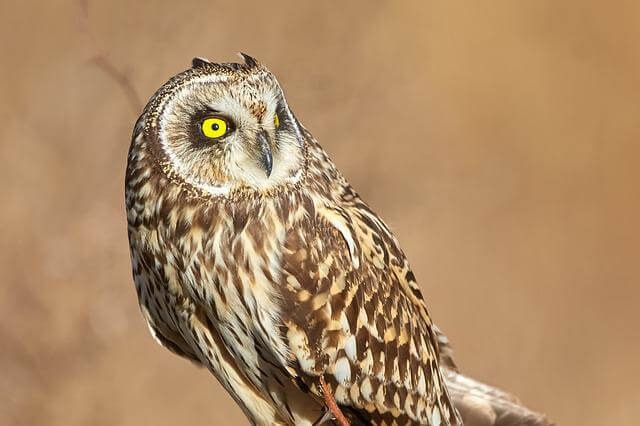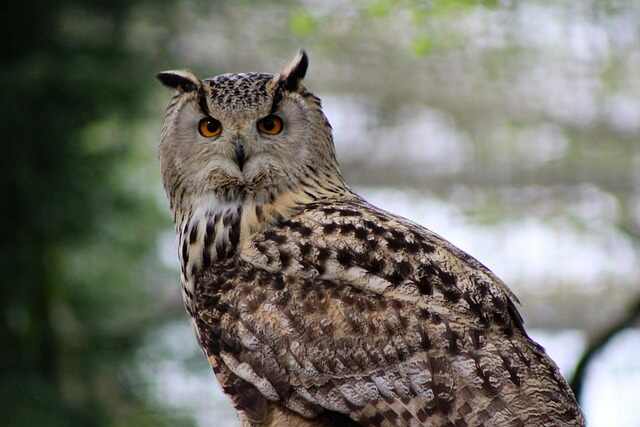How long do owls live? Short answer: It depends on the species and various other factors. But did you know that some owls can live up to 30 years? That’s a lot of hooting and hunting!
In this article, we’ll take a closer look at the average lifespan of owls, factors that influence their longevity, and the oldest known owl. So, grab your binoculars and let’s learn about these fascinating birds!
Table of Contents
- 1 The Average Owl Life Cycle
- 2 Owl Life Expectancy: How Long Do They Live?
- 3 Owl Lifespan for Different Species
- 4 Common Causes of Owl Deaths
- 5 What is the Oldest Owl Known?
- 6 Conclusion
- 7 FAQs About How Long Do Owls Live?
- 7.1 How long do owls typically live in the wild?
- 7.2 What is the average lifespan of a captive owl?
- 7.3 Do different owl species have different lifespans?
- 7.4 What factors affect an owl’s lifespan?
- 7.5 Do male or female owls live longer?
- 7.6 Can owls live in captivity for their entire lifespan?
- 7.7 What is the oldest recorded age for an owl?
- 7.8 What is the shortest lifespan of an owl species?
- 7.9 Do owls have a shorter lifespan in urban areas?
- 7.10 Can owls die of old age?
- 8 Author
The Average Owl Life Cycle
Owls, like most birds, have a distinct life cycle that progresses through several stages. Understanding the various stages of an owl’s life can give us insight into their behavior, needs, and overall health.
Egg and Newly Hatched Owls
The first stage of an owl’s life cycle begins with the egg. Female owls lay their eggs in nests, which are typically located in tree cavities, on cliffs, or on the ground. The number of eggs laid varies depending on the species, but most owls lay between one and six eggs.
After the eggs are laid, they are incubated by the female owl for a period of time that varies by species. Once the eggs hatch, the newborn owls are completely dependent on their parents for survival. They are born with their eyes closed and a layer of downy feathers that keep them warm.
Young Owls
As the young owls grow, they begin to develop their adult feathers and their eyes start to open. At this stage, they are still reliant on their parents for food and protection. The parents bring food to the nest and may spend several weeks teaching the young owls how to hunt and fly.
During this stage, young owls are incredibly vulnerable to predators and environmental threats. Many do not survive to adulthood, which is why it’s crucial to protect their habitats and minimize human disturbance.
Adult Owls
Once the young owls are fully grown and capable of hunting and surviving on their own, they leave the nest and become independent. Adult owls are typically solitary and territorial, with the exception of some species that mate for life and raise their young together.
Owls can live for many years in the wild, but their lifespan varies by species and is influenced by factors such as predation, disease, and environmental conditions.
For example, some species of owls that live in colder climates may have shorter lifespans due to harsh winter conditions and limited food availability.
In conclusion, understanding the life cycle of owls can help us appreciate these remarkable birds and their unique adaptations.
From egg to adult, each stage of an owl’s life has its own challenges and requirements for survival. Protecting owl habitats and minimizing human disturbance can help ensure that future generations of owls continue to thrive in the wild.
Owl Life Expectancy: How Long Do They Live?
Owls are remarkable birds of prey that can be found in many parts of the world. Their lifespan varies depending on several factors, such as species, habitat, diet, and predators. In this section, we will explore some of the key factors that influence the lifespan of owls.
Factors that Influence an Owl’s Lifespan
- Species: Different species of owls have different lifespans. For example, the average lifespan of a Great Horned Owl is around 13 years, while a Snowy Owl can live up to 20 years.
- Habitat: The habitat in which an owl lives can significantly affect its lifespan. Owls that live in areas with a higher risk of human intervention or natural disasters may have a shorter lifespan.
- Diet: An owl’s diet also plays a role in its lifespan. Owls that have access to a diverse range of prey may live longer than those with limited food options.
- Predators: Owls are vulnerable to various predators, including humans, other birds of prey, and mammals. The risk of predation can impact an owl’s lifespan.
The Average Lifespan of Owls in the Wild and in Captivity
In the wild, the lifespan of owls varies depending on the factors discussed above. On average, most owl species live between 10 and 20 years, with some species, like the Barn Owl, living up to 25 years. However, some owls have been known to live much longer.
For example, a captive Great Horned Owl named “Bubo” lived to be over 38 years old. In captivity, owls generally live longer than their wild counterparts due to better access to food, medical care, and protection from predators.
However, captive owls can also face unique health challenges, such as obesity and malnutrition, that can impact their lifespan. Overall, the lifespan of an owl is influenced by a variety of factors, and it varies greatly depending on the species and its environment.
Understanding these factors is essential in ensuring the conservation and protection of these magnificent birds.
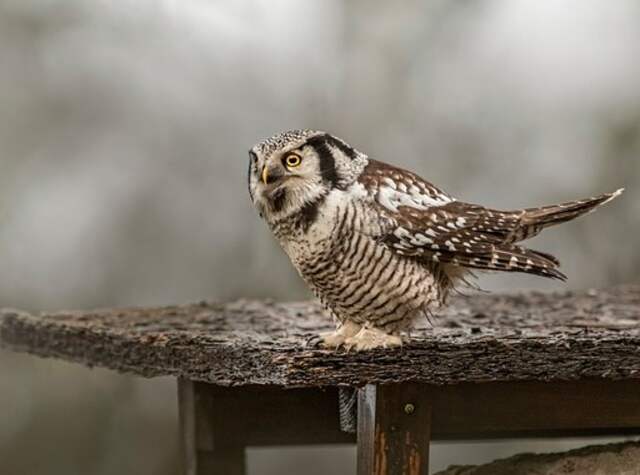
Owl Lifespan for Different Species
Owls come in a variety of shapes, sizes, and colors, and each species has its own unique set of characteristics, including lifespan. In this section, we will take a closer look at some of the most common owl species and their typical lifespans.
Overview of Different Owl Species and Their Lifespans
Flammulated Owl
The Flammulated Owl, a tiny owl found in western North America, has an average lifespan of 4 to 5 years in the wild, but has been known to live up to 9 years in captivity.
Burrowing Owl
Burrowing Owls are small, ground-dwelling owls found throughout North and South America. They have an average lifespan of 6 to 8 years in the wild, but have been known to live up to 11 years in captivity.
Boreal Owl
The Boreal Owl is a medium-sized owl found throughout the boreal forests of North America and Eurasia. They have an average lifespan of 7 to 8 years in the wild, but have been known to live up to 16 years in captivity.
Snowy Owl
Snowy Owls are a species of large, white owls that inhabit the Arctic regions of North America and Eurasia. They have an average lifespan of 9.5 years in the wild, but have been known to live up to 28 years in captivity.
Barn Owl
The Barn Owl has a global presence and is considered to be one of the most geographically widespread owl species. They have an average lifespan of 4 years in the wild, but have been known to live up to 20 years in captivity.
Barred Owl
The Barred Owl is a medium-sized owl found throughout North America. They have an average lifespan of 10 years in the wild, but have been known to live up to 23 years in captivity.
Spotted Owl
The Spotted Owl is a large owl found in the forests of western North America. They have an average lifespan of 10 to 12 years in the wild, but have been known to live up to 25 years in captivity.
Eastern Screech Owl
The Eastern Screech Owl is a small owl found throughout eastern North America. They have an average lifespan of 8 to 10 years in the wild, but have been known to live up to 14 years in captivity.
Western Screech Owl
The Western Screech Owl is a small owl found in western North America. They have an average lifespan of 7 to 9 years in the wild, but have been known to live up to 14 years in captivity.
Short-eared Owl
The Short-eared Owl is a medium-sized owl found throughout the world. They have an average lifespan of 4 to 5 years in the wild, but have been known to live up to 10 years in captivity.
Elf Owl
The Elf Owl is the smallest owl species in the world, found in the southwestern United States and Mexico. They have an average lifespan of 2 to 3 years in the wild, but have been known to live up to 14 years in captivity.
Great Gray Owl
The Great Gray Owl is a large owl found in the boreal forests of North America and Eurasia. They have an average lifespan of 4 to 5 years in the wild, but have been known to live up to 30 years in captivity.
Great Horned Owl
The Great Horned Owl is one of the largest owl species in the world, found throughout North and South America. They have an average lifespan of 13 years in the wild, but have been known to live up to 38 years in captivity.
| Owl Species | Lifespan in the Wild | Lifespan in Captivity |
|---|---|---|
| Great Horned Owl | 13 years | Up to 38 years |
| Snowy Owl | 9.5 years | Up to 28 years |
| Barn Owl | 4 years | Up to 25 years |
| Burrowing Owl | 9 years | Up to 10 years |
| Eastern Screech Owl | 6.5 years | Up to 14 years |
| Western Screech Owl | 6.5 years | Up to 14 years |
| Boreal Owl | 7 years | Up to 16 years |
| Spotted Owl | 15 years | Up to 18 years |
| Northern Saw-whet Owl | 7 years | Up to 8 years |
| Flammulated Owl | 7.5 years | Up to 8 years |
| Northern Pygmy-Owl | 7 years | Up to 10 years |
| Long-eared Owl | 4 years | Up to 27 years |
| Short-eared Owl | 4 years | Up to 15 years |
| Northern Hawk Owl | 6.5 years | Up to 13 years |
| Elf Owl | 4 years | Up to 8 years |
| Great Gray Owl | 9 years | Up to 40 years |
Note: Lifespan can vary depending on factors such as habitat, food availability, and environmental conditions. The lifespan in captivity can also vary depending on the care and conditions provided by the caretaker.
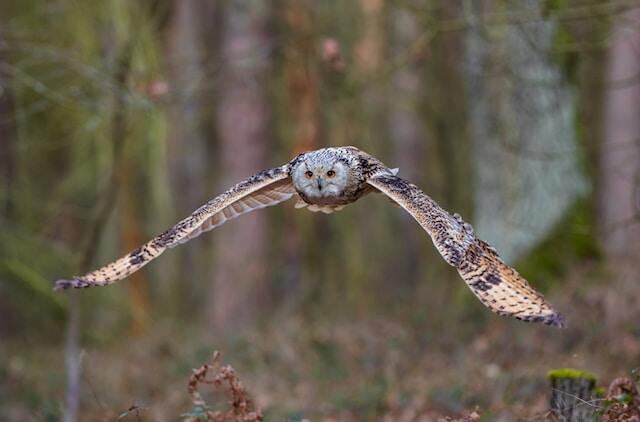
Common Causes of Owl Deaths
Owls are majestic creatures that play a crucial role in balancing the ecosystem. However, various natural and human-made threats contribute to their declining populations. In this section, we’ll take a closer look at some of the most common causes of owl deaths.
Natural threats:
- Starvation – Owls depend on a steady food supply, and any disruption in their food chain can lead to starvation.
- Weather conditions – Extreme weather conditions such as heavy snowfall, flooding, and drought can impact owl populations by destroying their habitats and making it difficult to hunt.
- Predators – Many species of owls are vulnerable to larger predators such as eagles, hawks, and coyotes.
- Disease – Like all animals, owls are susceptible to various diseases that can weaken their immune system and lead to death.
Human-made threats:
- Habitat loss – Urbanization, deforestation, and agriculture expansion have led to the loss of natural habitats for owls, disrupting their nesting and hunting patterns.
- Pesticides and pollution – Owls are at risk of ingesting harmful chemicals and pollutants that accumulate in their food chain, leading to illness and death.
- Accidental trapping – Owls can get caught in traps and snares set by humans for other animals, leading to injury or death.
- Poaching – Owls are often captured for illegal trade as pets or for their body parts, leading to a decline in their population.
How we can help protect owls and their habitats:
- Support conservation efforts – By donating to wildlife conservation organizations or volunteering at local wildlife rehabilitation centers, you can help protect owl populations and their habitats.
- Reduce pesticide and chemical use – Using eco-friendly products and reducing pesticide use can help prevent pollution and contamination of the owl’s food chain.
- Protect natural habitats – Support land conservation efforts and sustainable land use practices to protect natural habitats for owls and other wildlife.
- Educate others – Raising awareness about owl conservation and their importance in balancing the ecosystem can help prevent harm to owl populations.
By taking these steps, we can help protect these magnificent creatures and ensure that they continue to thrive in their natural habitats for generations to come.
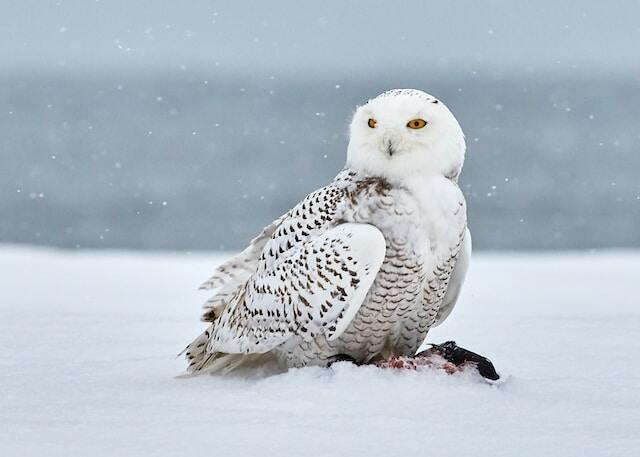
What is the Oldest Owl Known?
Owls are known for their longevity and can live up to 30 years, depending on the species and various factors. But have you ever wondered what the oldest owl in history is? In this section, we’ll take a brief look at the oldest recorded owl and explore why some captive owls live longer than their wild counterparts.
The oldest owl on record:
The oldest known owl on record was a Great Horned Owl that lived to be 38 years and 3 months old. The owl was banded in Ohio in 1963 and found dead in the same state in 2001. This record-breaking owl lived almost twice as long as the average lifespan of a Great Horned Owl.
Why do some captive owls live longer?
Captive owls are known to live longer than their wild counterparts, mainly because they are protected from many natural threats and receive regular medical care. In addition, captive owls are provided with a stable food source and living environment, reducing their stress levels and increasing their chances of survival.
However, it’s important to note that captivity can also have negative effects on owls, such as reduced physical activity and increased boredom, which can lead to health problems.
Owls are wild animals that thrive in their natural habitats, and it’s essential to provide them with the care and environment they need to maintain their physical and mental health.
In conclusion, the oldest recorded owl in history was a Great Horned Owl that lived to be 38 years and 3 months old. Captive owls are known to live longer than their wild counterparts, but it’s important to provide them with appropriate care and a natural environment to ensure their well-being.
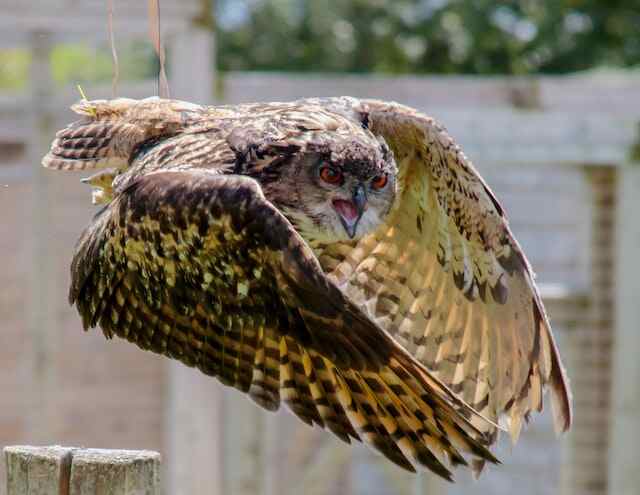
Conclusion
In conclusion, the lifespan of owls varies by species and factors such as habitat destruction and hunting threaten owl populations worldwide. Understanding their lifespans helps us appreciate the importance of conservation efforts to protect these magnificent birds for future generations.
FAQs About How Long Do Owls Live?
How long do owls typically live in the wild?
Most wild owl species have a lifespan of around 10–15 years, although some larger species can live up to 25 years in the wild.
What is the average lifespan of a captive owl?
Owls kept in captivity can live significantly longer than those in the wild, with some species living up to 30 years or more.
Do different owl species have different lifespans?
Yes, the lifespan of an owl can vary significantly depending on its species, with some living only a few years while others can live up to 50 years.
What factors affect an owl’s lifespan?
Factors such as diet, habitat, predation, disease, and human interference can all impact an owl’s lifespan.
Do male or female owls live longer?
In most owl species, females tend to live longer than males.
Can owls live in captivity for their entire lifespan?
Yes, owls can live their entire lifespan in captivity as long as they are provided with proper care and conditions.
What is the oldest recorded age for an owl?
The oldest recorded age for an owl is a wild Great Horned Owl that lived to be at least 28 years old.
What is the shortest lifespan of an owl species?
The shortest lifespan of any owl species is the Northern Saw-whet Owl, which typically lives only 3-4 years.
Do owls have a shorter lifespan in urban areas?
Yes, owls living in urban areas may have a shorter lifespan due to factors such as habitat loss, pollution, and collisions with vehicles.
Can owls die of old age?
Yes, like all living creatures, owls can die of old age when their bodies begin to fail, and they are no longer able to survive in the wild or captivity.


